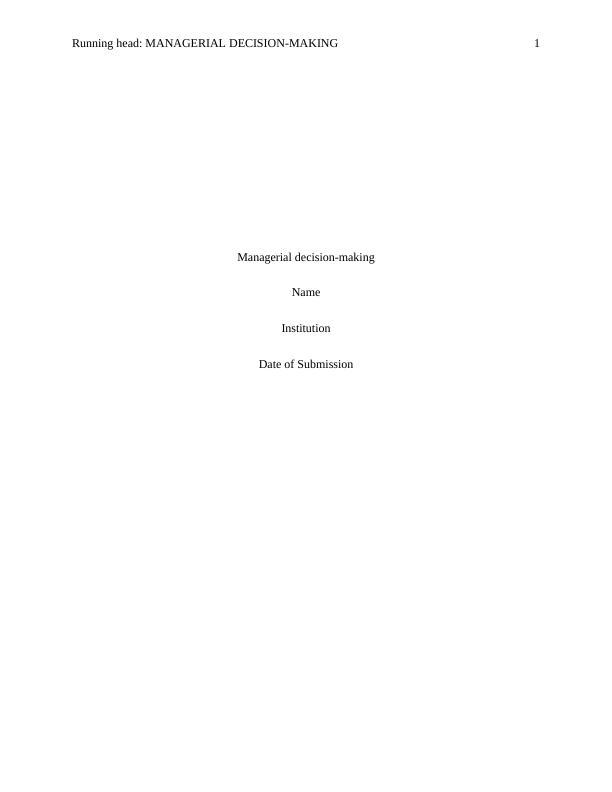Ask a question from expert
The Process of Decision Making
16 Pages4316 Words237 Views
Added on 2020-03-16
The Process of Decision Making
Added on 2020-03-16
BookmarkShareRelated Documents
Running head: MANAGERIAL DECISION-MAKING1Managerial decision-makingNameInstitutionDate of Submission

MANAGERIAL DECISION-MAKING2IntroductionDecision-making is a crucial process of every manager and top management of anorganization. The decisions that a company undertake determine the success or failure of thatcompany. Decision-making process, however, is not an easy process and it involves a lot ofuncertainty and risks (Sharma et al., 2014). As a manager, you need to make affirmativedecisions regarding various issues affecting the business operations. Herbert A. Simon, in hisbook titled, “Administrative Behavior,” tried to explain how an organization can be understoodbased on its decision-making processes. His key point that was so clear was the importance ofdecision-making in business operations, and therefore, he termed decision-making process as theheart of any administration (Simon, 2013). Nevertheless, in understanding how an organizationworks, it is crucial to put into consideration various factors and variables that affect the decision-making process. As such, psychology and economic theory come into play. Human behavior aswell organizational behavior determines the operations of a company (Forgas & George, 2001).As such, while trying to understand, how decisions are made by the managerial team, it isessential to realize how human behavior influences the decision-making process. Variousconcepts have been documented that shed light on different decision-making tendencies and howwe can overcome cognitive biases. This paper, therefore, discusses Simon’s quote from theRationality and Administrative Decision Making-section, to System 1&2 thinking, Boundedrationality, Judgement Heuristics, and Judgement and decision-making process. It will further,use case study scenarios to show the application of these concepts in decision-making process.

MANAGERIAL DECISION-MAKING3Part 1Simon’s theoryHerbert A. Simon has contributed significantly to the economic organization through hisexplanations of decision-making processes. Simon’s work particularly in his book, the‘Administrative Behavior” is very comprehensive and at the same time complex. If not keen, onecan miss the point he was trying to pass across. Simon’s theory is based on a rational, classical,and ideal model concerning human decision-making process (Simonsen, 1994). The rationalmodel proposed by Simon does not exist in real life. Therefore, it has received criticism fromvarious scholars. Simon knew this and he encouraged people not to criticize the model but tolook at the larger picture. The problem most people encountered was to understand howorganizations make decisions and thereby, be able to design organizations with total rationality. Rationality, however, is a variable that determines how organization make judgements,develop values and goals, gather information, and make decisions. In Simon’s quote, heexpounded on the issue of applying rationality behavior in problem-solving (Sternberg &Frensch, 2014). He stated that the human’s mental capacity is tiny in tackling complex problemsas compared to the weight that the problems carry. And the solution could only be found onobjective rationality. Human rationality gives the administrative theory meaning, and if therewere no practical limits to human rationality, then, Simon’s theory would lose meaning. Theselimits, however, are not static and they vary depending on organization’s environment wheredecisions take place. The primary task of the administration of any organization is to create anenvironment that is very close to rationality (Scott & Davis, 2015) hence allowing individuals tomake their decisions.

MANAGERIAL DECISION-MAKING4Making rational decisions involves making a choice and deciding to do a task with theaim of achieving a particular goal. Limitation of the human brain to handle complex matters asexplained by Simon can be attributed to the environment that surrounds an individual. Thesurroundings entrap and catch them in the ambiance of stress, thereby limiting their thinkingcapacity. Normally, when a child is born, the mind is very fresh, and as John Locke, thephilosopher calls it, a tabula rasa, meaning it’s a blank sheet (Eriksen & Nielsen, 2017), with nocontamination. As the child grows and attains maturity, level of understanding jets in and candistinguish right from wrong and make their own decisions. During this stage, there is theformation of complex concepts and theories and application of rationality behavior. Simon alsogave his ideas on an economic man and administrative man. For an economic man, he representsthe objective rationality (Brette et al., 2017). It comes with limitations, however, such as values,habits, unconscious skills, reflexes, and purpose conceptions. Surprisingly, these factors make aperson to lose track of the goals of the organization due to the openness of his mind and freedomto choose. By employing a rational mind, various alternatives are provided from which an individualcan choose. However, in actual behavior, it’s only a few options that come to mind. ThoughSimon in his quote indicated that man is limited by his brain capacity to handle problems, hefurther gave the difference between an economic and administrative man. An economic mantackles the real world head-on with all its complexity as compared to an administrative man whoselects the most crucial and significant problems (Takahashi, 2015). Contrary to his belief, thehuman mind is so diverse that they can be able to tackle any problem provided they decide to doso. An administrative man is keen in seeking and finding a satisfactory solution to a problem by

End of preview
Want to access all the pages? Upload your documents or become a member.
Related Documents
Managerial Decision Making - Essaylg...
|8
|2197
|15
Managerial Decision Making: Critical Examination of Simon’s Quotelg...
|11
|2192
|174
9 Examples of Managerial Decisionslg...
|9
|2260
|13
Assignment Concepts of Decision Makinglg...
|8
|2037
|49
Decision-Making in the Real World Assignment PDFlg...
|16
|3897
|46
Simon’s Theory and Decision Making Conceptslg...
|10
|2252
|98